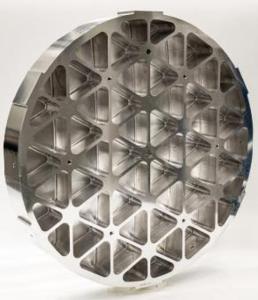Joining process for manufacturing of large Aluminium-based optical mirrors

To develop a joining process for manufacturing large, low roughness optical mirrors in Aluminium-based alloys.
Aluminium-based alloys obtained by a rapid solidification process have been successfully used for manufacturing optical mirrors. The maximum size of this type of aluminium mirrors is limited by the size of the billet, i.e. currently considered to be approximately 500 mm with and homogeneous microstructure. Consequently, the current manufacturing processes allow to produce mirrors with an effective area limited to a maximum dimension of 400 mm . The need for larger Aluminium-based mirrors is coming from scientific missions that require a large collecting area. The mirrors manufactured with rapidly solidified aluminium alloys are easy to polish down to nm scale roughness, possible due to their fine grain size. In addition, such mirrors have high thermal conductivity, good specific stiffness, and relatively low cost compared to optical ceramics. Furthermore, aluminium-based mirrors can easy match the CTE of scientific instruments, often manufactured in aluminium alloys.A possible way of increasing the attainable size of aluminium mirrors is to join together multiple mirror segments and to polish the mirror to the required surface roughness. Conventional fusion welding techniques applied on aluminium alloys would melt the parent metals and remove the fine-grained structure of rapidly solidified alloys. As a consequence, the polishing of the mirror will result in non-homogeneous surface roughness in the weld areas.Recent developments have made processes available which limit the impact on the parent materials? microstructure and the residual stresses in the joint e.g. solid state joining processes. The objective of this activity is to develop a process for joining segments of optical mirrors in aluminium-based alloys. The selected process shall give the possibility to achieve nm scale roughness while minimizing thermal stresses in the mirror structure. The activity shall encompass the following tasks:?- Trade-off to identify suitable Al-based alloys and joining methods. ?- Joining trails at specimen level for parameter optimization ?- Manufacturing of Al-based mirror demonstrator by joining a minimum of 3 segments. ?- Polishing of the demonstrator Al-based mirror. The mirror shall have an useful area corresponding to a diameter of at least 300mm and a shape representative of a telescope mirror, e.g. parabolic, spherical.?- Testing and characterization of a demonstrator Al-based mirror. Test shall include surface roughness, shape accuracy (below 40 nm), thermal stability, CTE, specific stiffness, mechanical properties.
